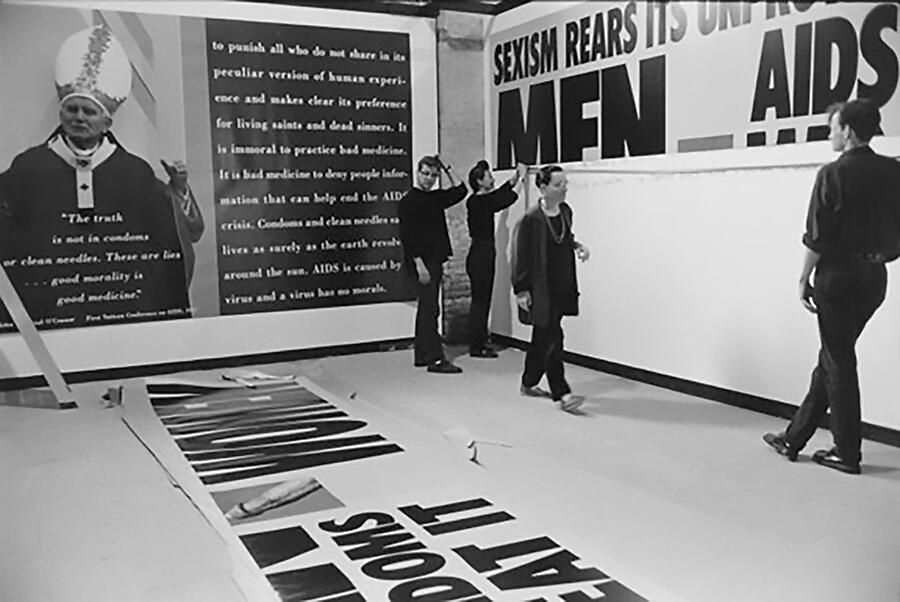The Pope, the Penis and the Phone
Avram Finkelstein looks back on Gran Fury’s contribution to the 1990 Venice Biennale, The Pope and the Penis, and considers how the immediacy of social media might have impacted the AIDS activist collective
Avram Finkelstein looks back on Gran Fury’s contribution to the 1990 Venice Biennale, The Pope and the Penis, and considers how the immediacy of social media might have impacted the AIDS activist collective
In the 1980s, I frequently spent months in London, and I couldn’t understand why everyone I knew either had or wanted a cell phone. My colleagues seemed fascinated by the prospect of constant accessibility – an idea that hadn’t hit America yet.
Since then, the lowly mobile phone has transmogrified into a pocket computer, and I can’t imagine life now without its constant slipstream of information. This leads me to wonder: if Gran Fury – the AIDS activist art collective from New York to which I belong – had access to the immediacy of social media, rather than having to rely on the arduous production process of the street poster, would our work have been as effective? Could we have fabricated commensurate social turf on the current communications landscape? Would we have been clickbait?

Since my Instagram traffic is anaemic compared to sites that feature male bodies in some form of undress, perhaps not. Social media delivers all kinds of data, but the content that grabs us by our scruff is still as primordial as desire, as ancient as the campfire. What triggers human response has more to do with Carl Jung than with Apple, so it follows that archetypes and codes would be internet gold. The algorithms edging us toward social ruin provide hefty proof of that. So, here it’s worth considering Gran Fury’s one notable analogue to this 21st-century image dilemma: The Pope and the Penis (1990).
As collective processes go, Gran Fury’s was, well, furious. In my experience, conflict was an essential component of our collaborative voice. As frequently as we agreed on something, me and my ten co-members – Richard Elovich, Amy Heard, Tom Kalin, John Lindell, Loring McAlpin, Marlene McCarty, Donald Moffett, Michael Nesline, Mark Simpson and Robert Vazquez-Pacheco – fought about it, often for weeks on end. In fact, not only did I strenuously object to participating in the XLIV Venice Biennale, I refused to travel to Italy to work on this piece. Our practice was devoted to public projects and we only showed in galleries if the work was mounted in public-facing windows or if it included a public component. Since the biennial offered no such assurances, I opposed our presence there. But I’m happy to have been proven wrong by the unexpected impact of The Pope and the Penis, and proud of the year of work on which the installation was based.

‘Why Make AIDS Worse Than It Is?’ was the question The New York Times felt compelled to ask in its editorial on 29 June 1989. Heterosexual transmission, they claimed, was only possible if women chose sex partners who were bisexual or injected drugs. Backed by a series of myopic statistics, they argued for calm in a way that leap-frogged over projections by the General Accounting Office and clinical data indicating that, by 1987, AIDS was the number one killer of women between the ages of 24 and 29 in New York. Their reasoning was so packed with racist and misogynistic tropes that the essay would likely never have been printed had it not come directly from the editorial board itself.
As it happened, our freshly formed Gran Fury collective had already weighed in on heterosexual transmission the year before, with a poster announcing a demonstration addressing women and AIDS. ‘SEXISM REARS ITS UNPROTECTED HEAD,’ the 1988 poster screamed in giant letters; in smaller capitals was flatly stated the predicament that ACT UP Women’s Caucus was focused on with gnawing precision: ‘AIDS KILLS WOMEN.’ It also included a snotty rejoinder that typified our voice: ‘MEN: Use Condoms or Beat It.’ Oh, and a large, erect penis pierced the entire text.

To say this work didn’t get the exposure it deserved when it was wheat-pasted around the streets of Manhattan in 1988 is an understatement. Alongside several pals from the Women’s Caucus, I was in one of the crews tasked with mounting this poster. When we went back to survey our assigned turf, the posters had vanished without a trace. No torn remnants were visible, implying they’d been peeled off the walls while they were still wet. Someone, it seemed, had followed in our wake, removing them as we put them up. The posters barely saw the light of day.
A distinctive yet overlooked feature of Gran Fury’s output is how heavily recycling factored into our practice. With some exceptions, we insistently hammered away at phrases, images or subjects we perceived as having had insufficient airing. In fact, much of our output spun off projects imagined within our first year – in particular, the suite of posters advertising nine days of ACT UP actions responsible for the genesis of Sexism Rears Its Unprotected Head (1988). Gran Fury had a very deep affection for this particular work, thinking it simultaneously hilarious and truthful. So, when we were given the opportunity to participate in the Biennale, we couldn’t resist reinventing it – this time in lurid colour – as a companion to an inflammatory indictment of the Catholic Church’s opposition to condom use.

As threatening as the saga of the Venice Biennale was to the collective in real time, it also had a slapstick aspect to it. The details are chronicled through the collective’s recollections in the 80WSE exhibition catalogue, Read My Lips (2011). These included: seizure of the work by Italian customs; a visit by the United States Information Agency; threats of arrest; a boycott of its censorship by other artists; our hiding the work near the garbage containers of a pizzeria; a visit by magistrates; proposed legal action by the Italian Parliament; and national tabloid coverage of the work that far exceeded its exposure in art-media outlets.
Looking back from the 21st century, this work has an art-historical frame that scaffolds many mythologies about art as social justice. In real time, however, the tale was delivered to Italian doorsteps through one of the most unsophisticated forms of storytelling: tabloid journalism, which is arguably the precursor to our current, conspiracy-laden, social-media zeitgeist. This juxtaposition of high and low cultural storytelling poses questions that land us on contemporary turf. Would this work have garnered attention without the firestorm caused by its unsheathed sexuality, its questioning of the Vatican’s mystical beliefs in its home country, or its go-fuck-yourself feminist and queer defiance? The art press covered the controversy, but how extensive would that have been if it hadn’t been fanned into a blaze by the tabloids?

This work landed smack in the middle of its cultural landscape, but it also offered a view from the margins, a distinguishing characteristic of queer questioning during the moment of its making. It landed in the middle because Gran Fury relied heavily on the centrality of advertising vernaculars, the folk language of capitalism. Although détournement was not original to us – nor were we the only artists exploring it – we squatted in advertising’s matter-of-factness, its insistence and its omnipresence, which we bent into a battle cry. I say our work is a view from the periphery because our strategic thinking was grounded on novel interpretations of queer activism, queer expression and queer rage stewing in lower Manhattan in the midst of a mass-death experience. Our collective was thrown together as a result of a nascent queer perspective that insisted the AIDS crisis was historically distinctive, and the attendant differentiations were a form of power.
So, would Gran Fury have thrived if the internet were the dominant media landscape? Possibly, since social media is simply our current form of content delivery – just as television, film, newspapers or broadsheets were before it. It might offer reinvented content formats – such as the meme – but the proliferation of communication platforms has bloated an image commons reliant on content into one that is unsustainable without it. Content, more than ever, is the coin of the realm.

Moreover, through years of mentoring young queer artists, I’ve observed that the successors of Gran Fury not only have a new relationship to public messaging, they have more of a relationship to it than previous generations. An international survey show of queer artists that I assembled for the Leslie-Lohman Museum in New York last year, ‘OMNISCIENT: Queer Documentation in an Image Culture’, probed generations of queer artists, who vividly map our image commons along the continuum Gran Fury utilized, and who see our digital landscape as an intricate ecosystem of power narratives representing fantasias of egalitarianism bridging the turn of the 20th and 21st centuries, and who articulate the tensions between access and limitation, literacy and legibility, marking and erasure, identity and colonization, agency and refusal.
Machine-learning may have morphed the image culture Gran Fury relied on into ever-expanding information conduits of Möbius non-orientability, but our image culture has not gone away. If anything, it has only grown in relative proportion; it has become incessant and is now as imperative as a volcano. And, while the internet poses as a universally accessible tool, it is actually a bottomless sea. Trying to get noticed online is like slipping a note into a bottle. Still, publics are more likely to see agitprop on their phones than they were on a Manhattan side street, or as B-roll on broadcast news.
So, if you’re perplexed about how to carve out a space for political art online, The Pope and the Penis is a useful case study. Or you could always just attach a naked torso to your messaging on Instagram.
This article first appeared in frieze issue 226 with the headline ‘The Pope, the Penis and the Phone’. For additional coverage of the 59th Venice Biennale, see here.
Main image: Gran Fury, Kissing Doesn’t Kill, 1990, ink on vinyl, 76 × 300 cm. Courtesy: Gran Fury and Avram Finkelstein















